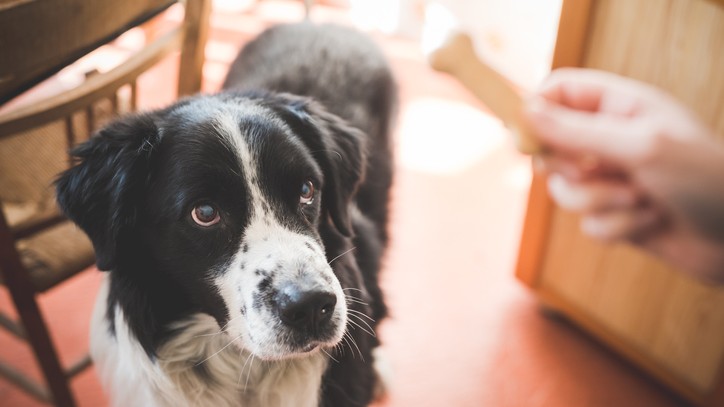Choosing healthy dog treats: A vet’s guide
How do you choose the best and most healthy dog treats for your dog? Check out our vet’s recommendations

Food is love and we love our dogs, so healthy dog treats are often at the top of many owners’ shopping lists! Lots of us use treats as a way to show our dogs just how much we love them, but treats also make great rewards during positive reinforcement training and are a convenient distraction when we need to keep our dogs occupied. But with so many options available in every pet store and online shop, how do you know which are the best dog treats for your dog? You could try them all, but that would certainly have an impact on your dog’s waistline! Before you purchase your next bag of dog treats, take a look at these tips for choosing healthy dog treats and avoiding the common pitfalls in the pet food aisle.
- The best puppy treats: Reward your young dog in style
- Best dental chews for dogs: Six options to keep your dog's teeth clean
- Make Your Own Homemade Dog Treats
Low-calorie dog treats
These are perhaps the healthiest treats for your dog, and best of all, these snacks come right from your own refrigerator! Whole food fruits and vegetables are a great low-calorie snack that’s high in essential nutrients. While they may not look or smell like the typical dog treat, many dogs still love them just as much as those crunchy bone-shaped snacks. Try offering your dog slices of sweet potato, baby carrots, or frozen blueberries as a treat. Not only are these snacks healthy, but your dog can eat a larger number of them for the same amount of calories when compared to the typical commercial dog treats. Fresh, home-cooked meat or bits of cheese can also make great high-value treats, particularly when you are training some more difficult tasks, but these are higher in calories and should be given in more careful moderation.
Although many fruits and vegetables are safe for dogs, be aware of those that may be toxic. Onions, garlic, and grapes are highly toxic to dogs and should never be given as treats. If you’re ever unsure about whether your dog can safely consume a particular food, it’s always best to consult your veterinarian first. You can also consult our guide to what human foods dogs can eat.
Rawhide dog treats, pig ears and bones
Rawhide dog treats and similar products such as pig ears and bully sticks have faced a lot of controversy over the years. Although some dogs eat rawhide treats regularly without issue, many pups experience digestive upset such as diarrhea after consuming rawhide. There are also concerns about bacterial contamination in rawhide treats and the risks of choking with smaller pieces of rawhide. Ultimately, many veterinarians recommend avoiding rawhide, including pig ears and bully sticks, especially if your dog is prone to digestive issues.
Rawhide treats and bones are also often too hard for a dog’s teeth, which can cause damage to the enamel and even break the teeth. Once a tooth is broken, expensive professional veterinary dental care performed under anesthesia is necessary to address the problem. For this reason, it’s best to avoid hard treats like bones, hooves, antlers, and hard rawhide. A good rule of thumb is that if you cannot indent the bone or treat with your thumbnail, it’s too hard for your dog’s teeth and could cause a fracture.

Freeze-dried dog treats
Freeze-dried dog treats are a favorite among many dog owners because they are portable, shelf-stable, easily broken into pieces, and highly palatable to many dogs. Many freeze-dried treats are also made from a single ingredient, such as fresh chicken or beef liver, which makes them a great option for dogs with food sensitivities such as allergies or digestive issues. However, many freeze-dried treats are made from raw meat, which poses high risks for bacterial contamination because the freeze-drying process does not kill most bacterial contaminants. If you do decide to use freeze-dried treats, look for products that have been cooked prior to freeze-drying to limit the risk of bacterial contamination.
Jerky treats for dogs
Jerky style treats are a favorite for many dogs because they are highly palatable. However, over the past few years the US Food and Drug Association (FDA) has been tracking reports of dogs becoming sick after eating jerky dog treats. The majority of cases have been linked to chicken jerky treats and products made in China, but other varieties and sources have also been implicated. To date, the organization has been unable to identify the cause of illness in dogs eating these treats. If you do decide to give your dog jerky treats, it’s best to look for products made locally out of an abundance of caution. However, the FDA notes that manufacturers are not required to the list country of origin on the product label. If your dog shows signs of illness after eating jerky treats, particularly symptoms such as increased drinking and urination, lethargy, loss of appetite, vomiting, or diarrhea, stop giving the treats and contact your veterinarian right away.
Crunchy, soft, chewy, and everything in between!
Commercial dog treats – the ones you find at every pet store – come in a dizzying array of flavors, textures, shapes, and sizes. What you choose for your dog largely depends on your own preferences, budget, and your dog’s personal tastes. Unfortunately, there’s no regulatory oversight on dog treats and very little required labeling, so it can be difficult to determine which products are safe and healthy for your dog. To be safe, it’s best to stick with brands you recognize and ingredients that you know your dog tolerates well. Your veterinarian may also be able to recommend brands and products that they trust.
The bottom line: Everything in moderation!
Almost every dog loves treats, but they aren’t necessary as part of a healthy diet and they can be a significant source of extra calories. As with everything in life, it’s best to give treats in moderation. A good rule of thumb is to limit treats to no more than 10% of your dog’s daily calorie intake. If your dog is overweight or obese, you may need to cut out treats entirely for his health. Fortunately, there are plenty of other ways to show your dog love, too!
PetsRadar Newsletter
Get the best advice, tips and top tech for your beloved Pets
Dr. Elizabeth Racine is a small animal general practice vet covering all things pet health and wellness. Her special interests include veterinary behavior, nutrition, and internal medicine.
As a freelance writer, Dr. Racine has written content for major companies in the industry such as the American Kennel Club, Merck Animal Health, Bayer PetBasics, Elanco, and CareCredit. In her free time, Dr. Racine enjoys playing trampoline dodgeball, hiking with her beagle Dasher, and spending time with her three mischievous cats.

